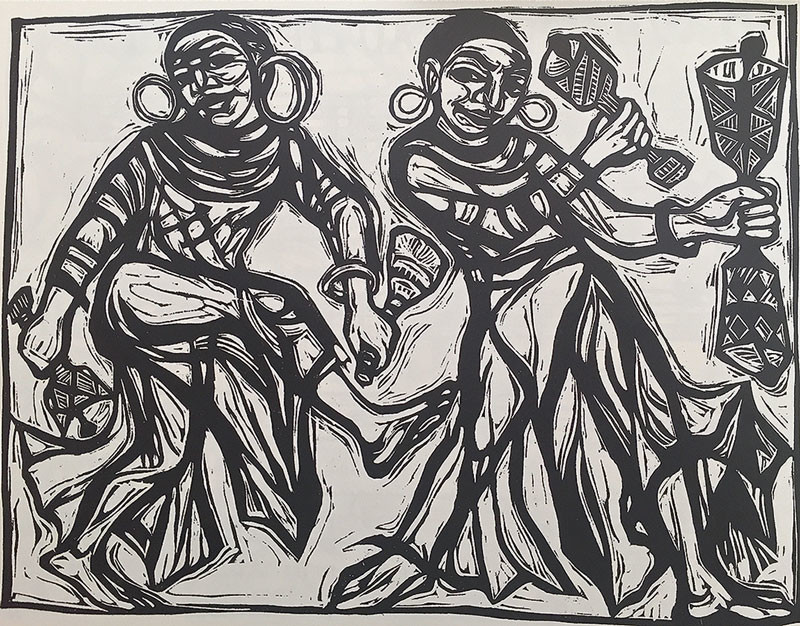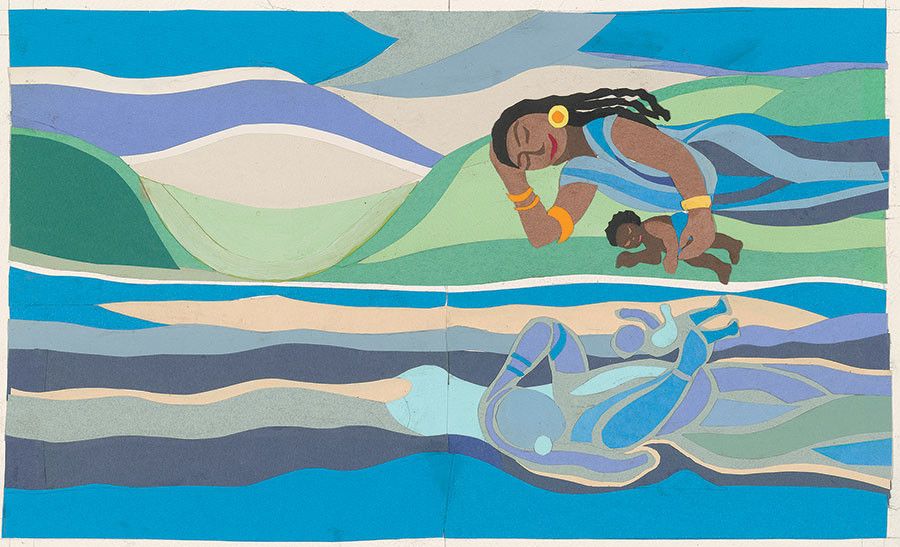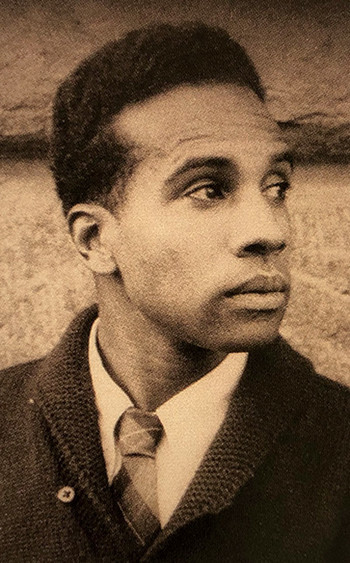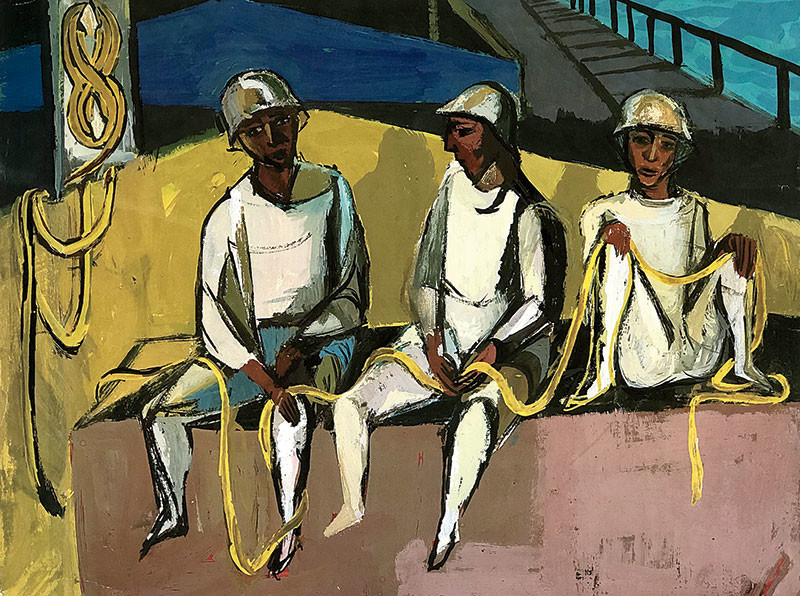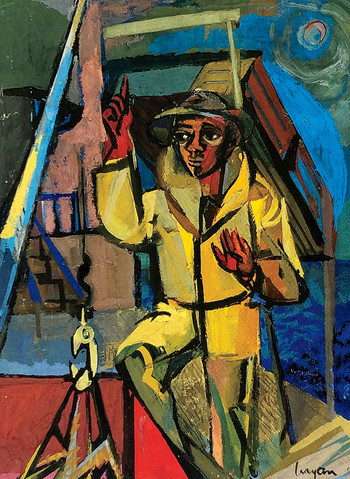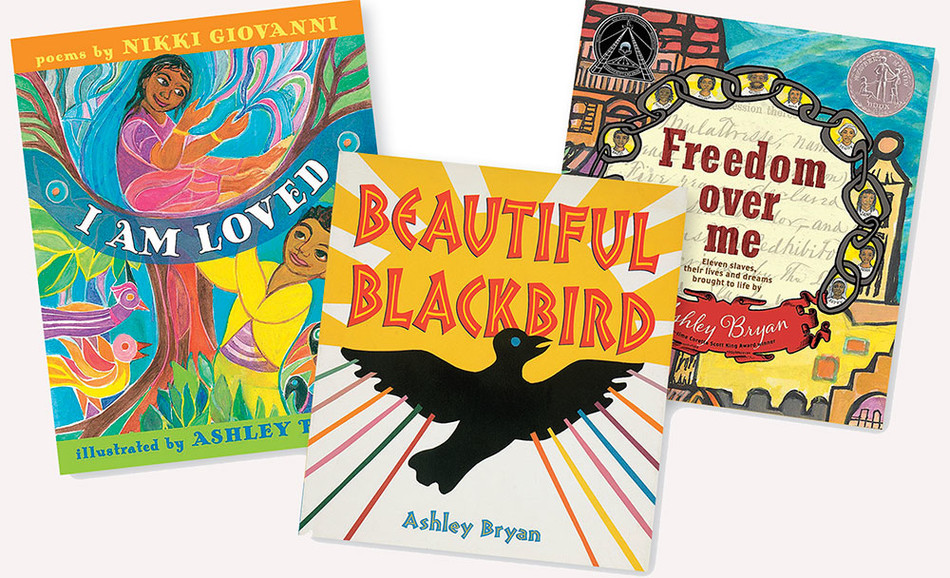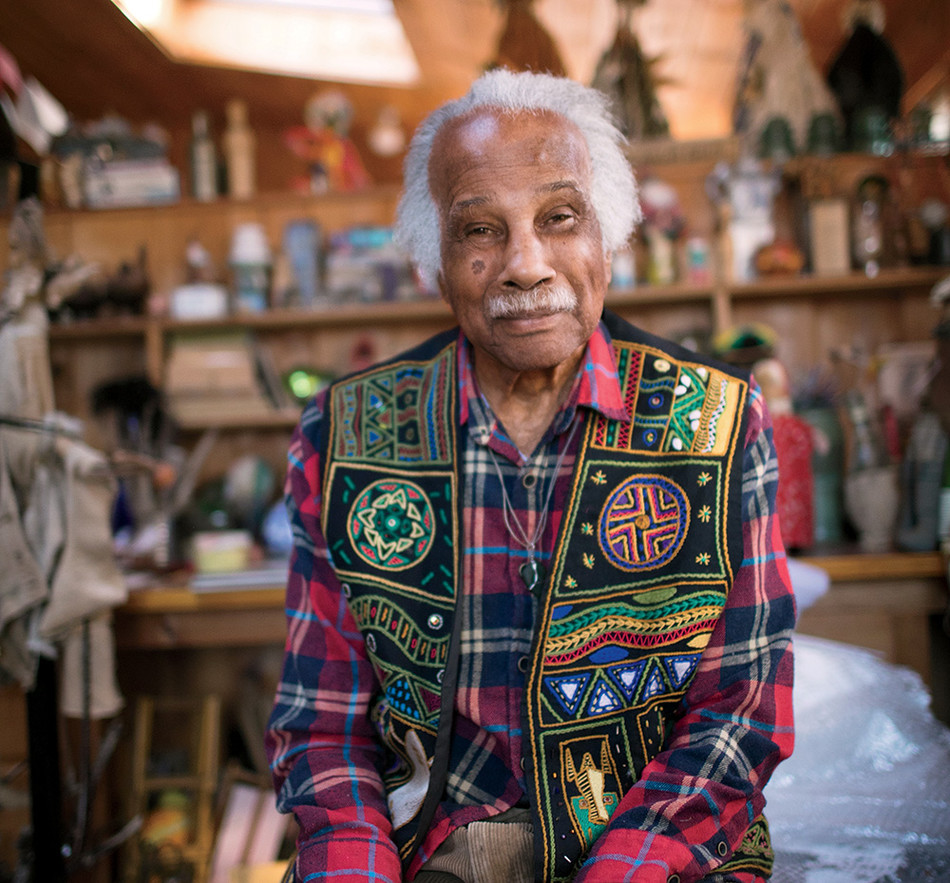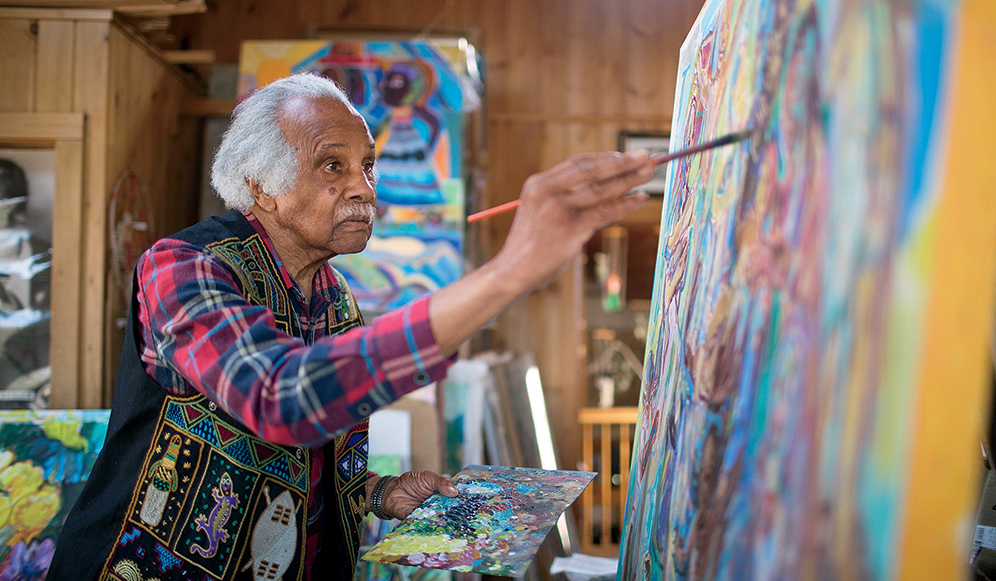
Once upon a time, there was a child who loved to make books.
He wrote words and drew pictures, cut out shapes from paper and glued them to pages, then bound those pages together with great care. He signed the covers “By Ashley Bryan” and happily gave his creations away. Even then he recognized that beauty was a gift — something to be shared.
Bryan '50GS would go on to train as an artist, and that love of books has defined his career. He has published some fifty books for children and received dozens of awards and honors, including the Coretta Scott King–Virginia Hamilton Award for Lifetime Achievement, the Children’s Literature Legacy Award, and the New York Public Library’s Library Lions award. As an artist, a teacher, a poet, and a memoirist, he has put education at the heart of his endeavors. There is a school named after him in Maine and a library named after him in Kenya. A professor emeritus of art at Dartmouth, he has received eleven honorary degrees.
At ninety-eight, Bryan still bubbles and brims with enthusiasm and delight and believes unshakably that the most important moment of his life is the one he is living now. Whether making books, puppets, or stained-glass windows or painting pictures of the irises and zinnias in his garden — whether working in pencil, watercolors, or woodcuts, or with stones and sea glass washed up on the shore near his home in Islesford, Maine — he approaches his work with the same sense of spontaneity and wonder that possessed him as a child. “All the things that I came across I turned into art,” he says. “My parents encouraged my love for creating, and so did my teachers. I was always encouraged to make whatever I could from the things I found.”
His creative energy seems limitless. In his nineties alone he has published seven books, including two of his most ambitious and acclaimed works for young audiences: Infinite Hope: A Black Artist’s Journey from World War II to Peace, a memoir; and Freedom Over Me, a powerful imagining of the lives of eleven enslaved people whose names are on an 1828 estate appraisal that Bryan acquired. “Ashley gets lifetime achievement awards, and then there’s another lifetime of work after that,” says his friend Carl Little ’80SOA, an art critic. “He is truly an amazing human being.”
“He’s an artist, he paints, but he’s a lover — he loves things,” says another close friend, the poet Nikki Giovanni. When asked about his approach to life, Bryan’s response is simple: “Never let the child in you die.”
A timeless spirit of invention flows through the tapestry of Bryan’s multimedia work, a fabric woven of myriad impressions and influences: African folktales and Bible stories, Black spirituals and Bach concertos, the Normandy beaches and the Maine coast, Monet and Picasso, poetry and God. Bryan rejects categorization: all the arts blend in him like pigments mixed on a palette. When he reads a story or recites a poem, it becomes theater. Bryan inhabits the text, plumbs it, summons voices, and brings out the musical and rhythmic inflections that the words demand. He is an artist who not only sees but listens.
Bryan says an abiding love of poetry and folktales gave him the desire to illustrate books. Words for Bryan hold an almost mystical influence and can move him as deeply as any landscape or figure. “Poetry always fills me with a sense of awe,” he says, his vivacious manner only slightly muted by time. “Poetry is the bedrock of life.”
This past spring, the Morgan Library & Museum in New York acquired Bryan’s preliminary drawings and cut-paper collages for Sail Away, his 2015 illustrated collection of Langston Hughes poems about water: oceans, rivers, rain. “There’s a wonderful connection between the experiences of Ashley Bryan and Hughes,” says Sal Robinson ’03CC, an assistant curator of literary and historical manuscripts at the Morgan. “They both went to sea as young men. Ashley served in World War II on supply boats, and Hughes, who attended Columbia briefly in the early 1920s, worked on merchant ships.”
In October 2022, the Morgan will honor Bryan with an exhibition featuring Sail Away and other works. “We want to explore the way both men thought about the sea and the role it plays in their lives,” Robinson says. For Bryan, that role is essential as air: for more than thirty years, he has lived full-time on the tiny Cranberry Isles, off the coast of Maine, surrounded by the sprays and mists and sparkling waves of the Atlantic.
Ashley Frederick Bryan was born in Harlem in 1923 and grew up in the Bronx. His parents, immigrants from the Caribbean island of Antigua, raised him, his five siblings, and three orphaned cousins in a tenement that also housed dozens of injured birds that his father, a printer of greeting cards, would bring home to rehabilitate. The neighborhood was diverse and included Black, Irish, Italian, French, German, and Jewish families, exposing Bryan to other cultures. As a child he fell in love with the stained-glass windows of nearby St. John’s Evangelical Lutheran Church and begged his mother to take him inside. They were the first Black people to enter the church, and the Bryans became its first Black congregants.
In his senior year at Theodore Roosevelt High School, Bryan, a promising art student in need of financial aid for college, sent out his portfolio, and he was told by one distinguished academy in the city that while his work was as good as any, it would be “a waste to give a scholarship to a colored person.” Bryan was stunned — this was New York, not Mississippi — but he weathered the blow. “I had such support from family, friends, and teachers,” he says, “that my love of art made me move past it and kept me going.”
His teachers urged him to apply to the Cooper Union, a prestigious tuition-free arts and engineering college where the admissions officers did not see the applicant, only the work. Bryan was accepted. But in May 1942, six months after the attack on Pearl Harbor and in the midst of his art studies, he was drafted into the segregated US Army and sent overseas.
The war had a profound impact on Bryan. He was a stevedore in an all-Black unit stationed at times in Scotland, Belgium, and France and responsible for unloading supplies and ammunition from ships for the D-day landing at Omaha Beach. Bryan took a sketchpad everywhere he could — he even kept one in his gas mask — and when pads were scarce he resorted to drawing on toilet paper. He drew the soldiers and the ships and sent his artworks home to his parents; he wrote searching, lyrical letters to an art-school friend, Eva Brussel.
For decades, he kept his war memories, captured in hundreds of sketches and letters, locked away in a drawer of his bureau. It was only several years ago, at a children’s literature seminar, that he first publicly mentioned that he had served in the war. The casual revelation surprised his listeners — there was nothing about Bryan to suggest a man acquainted with combat — and it initiated a difficult personal process that would culminate in Infinite Hope, published in 2019, when Bryan was ninety-six. He and his editor at Atheneum Books, Caitlyn Dlouhy, went through countless drawings and letters, and Bryan composed a moving account of the most painful period of his life. “Most veterans don’t talk,” Bryan writes in the book. “They want to live past the devastations and tragedies of their war experiences. It’s so hurtful to put yourself back in those places.” The accompanying sketches and paintings show the soul of the artist, while the letters reveal a young poet of twenty, precociously perceptive, distilling, through “the months of foxholes and stress,” his sadness, loneliness, fear, humiliation (at the hands of Southern white officers), faith, and love (for beauty, for art, for his fellows in the 502nd Port Battalion).
“The seagull is a soul,” he wrote in one letter to Brussel. “It is my lonely soul when I am down by the waterfront.” In another, he prayed: “Oh God, make me brave for life.”
“The war was horrible,” says Giovanni, “and Ash thought he should keep track of it. He was drawing all along. Everyone saw that Ash was not going to shoot anybody. He was going to draw.” Art saved him every day. Says Bryan, “I used my art to help me understand what I was experiencing.”
What he was experiencing was a life lived not just in the shadow of death, but under the pall of official racism: white officers would restrict Black soldiers’ socializing, send Black units to clear land mines, and allow German POWs to sit at the front of the buses while Black American soldiers rode at the back. When the war was over, Black soldiers were pulled off homebound ships that lacked the facilities for segregation and had to wait, sometimes for months, to return. And when they did arrive, there was no fanfare, no parades, and no respite from Jim Crow and racism generally.
Bryan struggled with all of this: death, destruction, injustice, and the enormity of atomic bombs being dropped on Japanese cities. He wanted answers, and “in an attempt to understand why men make war,” he says, he enrolled at Columbia’s School of General Studies on the GI Bill to study philosophy. During the summers he attended the Skowhegan School of Painting and Sculpture in Madison, Maine (it was on a visit to Maine’s Acadia National Park that he first glimpsed the Cranberry Isles). After graduating cum laude from Columbia — both his Army discharge papers and his diploma were signed by Dwight D. Eisenhower ’47HON — he went to the South of France to study art.
His arrival at Aix-Marseille University in the summer of 1950 coincided with an event that would help heal Bryan’s postwar trauma and forever change his art. Word came that Pablo Casals ’70HON, the great Spanish cellist who was living in exile in the French border town of Prades, would end his years-long musical silence in protest of the Spanish dictator Francisco Franco with a concert marking the bicentennial of the death of Bach. Musicians came from all over to play with Casals, and Bryan got permission to attend the rehearsals and sketch. In trying to capture the motion of the bow strokes, Bryan internalized, with his own strokes of the pen, the spirit of performance — and discovered a new way to move a paintbrush. As Bryan says, “I found the rhythm of my hand.”
By the mid-1960s, he had begun his publishing career, contributing illustrations for two books: a 1950 edition of the memoir Black Boy, by Richard Wright; and Fabliaux: Ribald Tales from the Old French, a collection of fables from the thirteenth and fourteenth centuries ornamented with Bryan’s block prints of bathing nudes and prancing horses. Then, in 1965, he read a piece in the Saturday Review by educator Nancy Larrick ’37TC that would alter his path. Titled “The All-White World of Children’s Books,” Larrick’s essay was prompted by a five-year-old Black girl at the Manhattanville Nursery School in New York, who, looking at a picture book, asked, “Why are they always white children?” The article jolted Bryan, who in his own schooling had learned so little about Black history or culture. Now he committed himself to celebrating Blackness through children’s literature.
Much of Bryan’s storytelling draws on Folk-Lore of the Antilles, French and English, a 1933 compendium of Afro-Caribbean tales collected by anthropologist Elsie Clews Parsons 1896BC, 1899GSAS. Bryan retells these stories in his own voice while channeling voices of the ancestors. He is also inspired by poetry: his first book for Atheneum, his publisher of more than half a century, was a series of illustrations for a 1967 selection of poems by the Nobel Prize–winning Bengali writer Rabindranath Tagore (Moon, For What Do You Wait?). Bryan has since wed images to his own poems as well as to the verse of Langston Hughes, Paul Laurence Dunbar (I Greet the Dawn, 1978), nineteenth-century British poet Christina Rossetti (Blooming Beneath the Sun, 2019), and Nikki Giovanni (The Sun Is So Quiet, 1996, and I Am Loved, 2018). “Ashley has a strong sense of poetry,” says Giovanni. “For I Am Loved I sent him poems and said, ‘Ash, you just choose whichever ones you feel like drawing.’ And I love what he did. Whenever you see Ashley’s art, you see warmth and happiness.”
Bryan joined the faculty of Dartmouth in 1974, and during his fourteen years as a professor he published, among other works, four volumes of Black American spirituals — for Bryan one of the great musical legacies in human history — illustrated with linocut prints. He retired from Dartmouth in 1988 and moved full-time to the town of Islesford on Little Cranberry Island. With its sea and sky and wildflowers, the island overflowed with gifts of nature; and at sixty-five, Bryan embarked on a period of astonishing productivity that continues today.
His beloved editor, Jean Karl, died in 2000, and shortly afterward Bryan met Dlouhy, then a young editor at Atheneum. They hit it off instantly. “I just love that man,” Dlouhy says. “He never has an unkind or negative word. It’s always, ‘Look at this beautiful thing. Look at this beautiful day. We’re alive.’”
Their first book together, Beautiful Blackbird, a retelling of a folktale of the Ila-speaking people of Zambia, done in vibrant cutout paper illustrations, remains one of Bryan’s favorites. In the story, birds of different colors — green, red, blue, pink, yellow, orange — come together to decide which of them is the most beautiful. The honor goes to Blackbird, whose black iridescence reflects all colors. The other birds want some black, too, and Blackbird, like a painter, touches each of them with a black feather, giving them black rings and markings, while reminding them that real beauty comes from within.
“In most books the color black is not regarded as beautiful,” Bryan says. “With that book, I wanted to open up black as a way of making beautiful art.”
To get to Bryan’s house, you take a mail boat from Northeast Harbor to Little Cranberry Island. With a population of less than a hundred, the island is home to the Ashley Bryan Center, a nonprofit started by Bryan’s friends to preserve and promote his work; the Ashley Bryan School, a two-room schoolhouse renamed for the artist in 2012; Islesford Congregational Church, its interior graced by Bryan’s stained-glass panels of scenes from the life of Jesus; and, less than a quarter mile from the dock, Bryan’s house, the interior of which Carl Little calls “one of the seven wonders, at least of Maine.”
Neighbors Dan and Katy Fernald live two houses away and have both known Bryan since they were children. Katy, owner of the Islesford Artists Gallery, recalls how she and other kids would follow Bryan around as he walked the beach in search of objects for his art. “Someone once called him the Pied Piper of Islesford,” she says with a laugh. Dan, a painter and lobsterman whose family has lived on the island for eight generations, says that whenever Bryan leaves town for conferences or readings, he befriends people and invites them to Islesford. “He’s very kind, welcoming, and gracious,” says Dan, “and there is a constant flow of visitors from all over the country.”
Those visitors, upon entering Bryan’s home, are startled by what they see: an exuberant profusion of objects crowding every surface: figurines, mechanical toys, handmade dolls, whirligigs, ceiling mobiles, and other trinkets collected over decades of travels. “The house is a children’s wonderland,” says Dlouhy. “Toys are everywhere — everywhere. If you brush against one on a shelf, four hundred will come toppling down on you.”
Bryan has two studios in the house. Upstairs, buoyed by views of the harbor and his gardens, he does his painting and block-print work. In the downstairs studio he crafts puppets out of driftwood and other things gathered from the beach. “These puppets are unlike anything in the world,” says Dlouhy. “They’re remarkable not only in how he constructs them — it’s all found objects — but also the stories: as he is making them, they start talking to him and telling him who they are, going back to the ancestors and Africa.” As a gift to Giovanni, Bryan made a puppet with a fish skull for a head and a body draped in fabric, twine, and beads. “He named it Wambut,” Giovanni says. “It’s an East African name that means ‘singer of songs.’ I’m so honored. Coming into my home, it’s the first thing you see.”
“For me, Ashley is the closest thing to a prophet or holy man,” says Little. “You feel like you want to touch the hem of his garment. It’s that kind of thing. He’s all giving.”
It’s this generosity and openness that allows Bryan to abandon any discrimination between artistic forms: paintings or puppets, woodcuts or collage, sketches or stained glass — they’re all one to him. “My overarching theme is the love of making art, no matter what the material,” he says. “My love of art makes me excited with the thought of using any materials and transforming them into something creative.”
In that way, he’s no different now than he was as a kid in the Bronx during the Depression, making art out of whatever he found. Now, as then, Bryan enjoys the love and support of family and friends. But more than anything else, art itself has sustained him, and his love for it continues to make him want to share it — especially with children, whose eager sense of discovery lives within him each day.
“I hope that through my work, children will see what is beautiful in them and explore art,” he says. “Making art is one of the most adventurous experiences you can have. So always make art, always.”
Ashley Bryan died on February 4, 2022. More information can be found at ashleybryancenter.org.
This article appears in the Fall 2021 print edition of Columbia Magazine with the title "Oh God, Make Me Brave for Life."
